The Sandy Bridge Review: Intel Core i7-2600K, i5-2500K and Core i3-2100 Tested
by Anand Lal Shimpi on January 3, 2011 12:01 AM ESTThe 6-series Platform
At launch Intel is offering two chipset families for Sandy Bridge: P-series and H-series, just like with Lynnfield. The high level differentiation is easy to understand: P-series doesn’t support processor graphics, H-series does.
There are other differences as well. The P67 chipset supports 2x8 CrossFire and SLI while H67 only supports a single x16 slot off of the SNB CPU (the chip has 16 PCIe 2.0 lanes that stem from it).
While H67 allows for memory and graphics overclocking, it doesn’t support any amount of processor overclocking. If you want to overclock your Sandy Bridge, you need a P67 motherboard.
6Gbps
Had SSDs not arrived when they did, I wouldn’t have cared about faster SATA speeds. That’s how it worked after all in the evolution of the hard drive. We’d get a faster ATA or SATA protocol, and nothing would really change. Sure we’d eventually get a drive that could take advantage of more bandwidth, but it was a sluggish evolution that just wasn’t exciting.
SSDs definitely changed all of that. Today there’s only a single 6Gbps consumer SSD on the market—Crucial’s RealSSD C300. By the middle of the year we’ll have at least two more high-end offerings, including SandForce’s SF-2000. All of these SSDs will be able to fully saturate a 3Gbps SATA interface in real world scenarios.
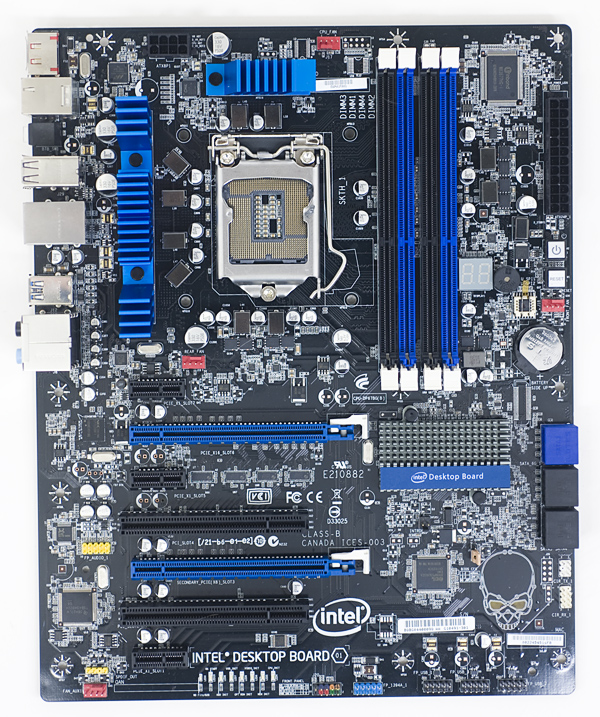
Intel's DP67BG—The blue SATA ports on the right are 6Gbps, the black ones are 3Gbps
To meet the soon to be growing need for 6Gbps SATA ports Intel outfits the 6-series PCH with two 6Gbps SATA ports in addition to its four 3Gbps SATA ports.
I dusted off my 128GB RealSSD C300 and ran it through a bunch of tests on five different platforms: Intel’s X58 (3Gbps), Intel’s P67 (3Gbps and 6Gbps), AMD’s 890GX (6Gbps) and Intel’s X58 with a Marvell 9128 6Gbps SATA controller. The Marvell 91xx controller is what you’ll find on most 5-series motherboards with 6Gbps SATA support.
I ran sequential read/write and random read/write tests, at a queue depth of 32 to really stress the limits of each chipset’s SATA protocol implementation. I ran the sequential tests for a minute straight and the random tests for three minutes. I tested a multitude of block sizes ranging from 512-bytes all the way up to 32KB. All transfers were 4KB aligned to simulate access in a modern OS. Each benchmark started at LBA 0 and was allowed to use the entire LBA space for accesses. The SSD was TRIMed between runs involving writes.
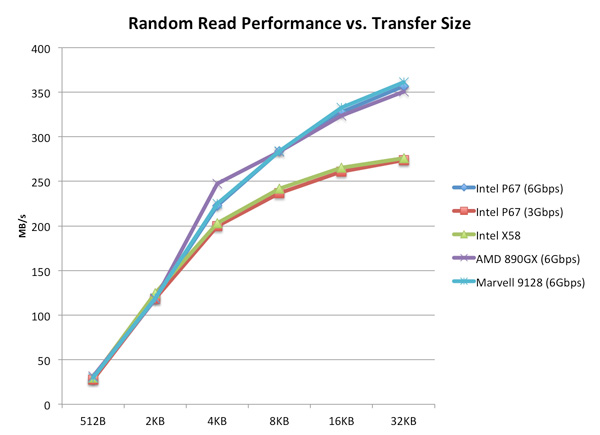
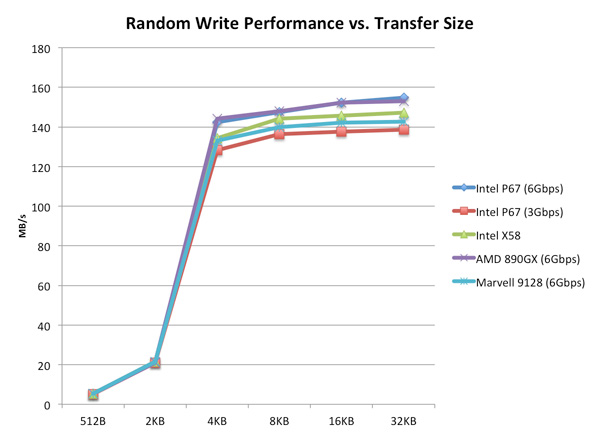
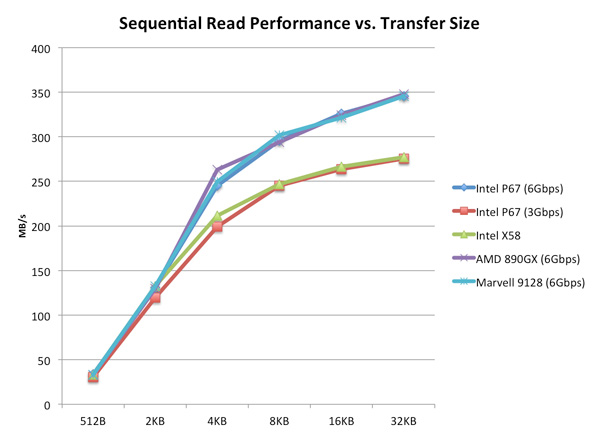
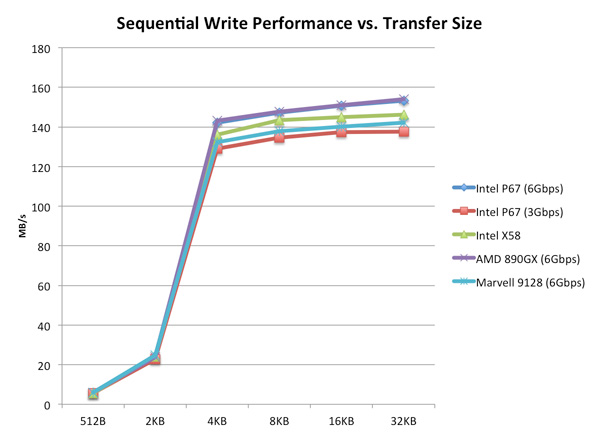
Among Intel chipsets I found that the X58 has stellar 3Gbps SATA performance, which is why I standardize on it for my SSD testbed. Even compared to the new 6-series platform there are slight advantages at high queue depths to the X58 vs. Intel’s latest chipsets.
Looking at 6Gbps performance though there’s no comparison, the X58 is dated in this respect. Thankfully all of the contenders do well in our 6Gbps tests. AMD’s 8-series platform is a bit faster at certain block sizes but for the most part it, Intel’s 6-series and Marvell’s 91xx controllers perform identically.
I hate to be a bore but when it comes to SATA controllers an uneventful experience is probably the best you can hope for.


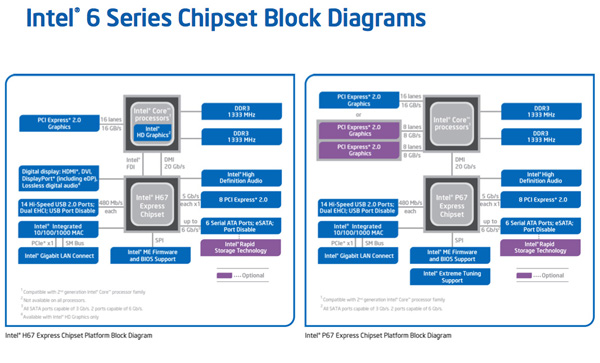








283 Comments
View All Comments
nuudles - Monday, January 3, 2011 - link
Anand, im not the biggest intel fan (due to their past grey area dealings) but I dont think the naming is that confusing. As I understand it they will move to the 3x00 series with Ivy Bridge, basically the higher the second number the faster the chip.It would be nice if there was something in the name to easily tell consumers the number of cores and threads, but the majority of consumers just want the fatest chip for their money and dont care how many cores or threads it has.
The ix part tells enthusiasts the number of cores/threads/turbo with the i3 having 2/4/no, the i5 having 4/4/yes and i7 4/8/yes. I find this much simpler than the 2010 chips which had some dual and some quad core i5 chips for example.
I think AMD's gpus has a sensible naming convention (except for the 68/6900 renaming) without the additional i3/i5/i7 modifier by using the second number as the tier indicator while maintaining the rule of thumb of "a higher number within a- generation means faster", if intel adopted something similar it would have been better.
That said I wish they stick with a naming convention for at least 3 or 4 generations...
nimsaw - Monday, January 3, 2011 - link
",,but until then you either have to use the integrated GPU alone or run a multimonitor setup with one monitor connected to Intel’s GPU in order to use Quick Sync"So have you tested the Transcoding with QS by using an H67 chipset based motherboard? The Test Rig never mentions any H67 motherboard. I am somehow not able to follow how you got the scores for the Transcode test. How do you select the codepath if switching graphics on a desktop motherboard is not possible? Please throw some light on it as i am a bit confused here. You say that QS gives a better quality output than GTX 460, so does that mean, i need not invest in a discrete GPU if i am not gaming. Moreover, why should i be forced to use the discrete GPU in a P67 board when according to your tests, the Intel QS is giving a better output.
Anand Lal Shimpi - Monday, January 3, 2011 - link
I need to update the test table. All of the Quick Sync tests were run on Intel's H67 motherboard. Presently if you want to use Quick Sync you'll need to have an H67 motherboard. Hopefully Z68 + switchable graphics will fix this in Q2.Take care,
Anand
7Enigma - Monday, January 3, 2011 - link
I think this needs to be a front page comment because it is a serious deficiency that all of your reviews fail to properly describe. I read them all and it wasn't until the comments came out that this was brought to light. Seriously SNB is a fantastic chip but this CPU/mobo issue is not insignificant for a lot of people.Wurmer - Monday, January 3, 2011 - link
I haven't read through all the comments and sorry if it's been said but I find it weird that the most ''enthusiast'' chip K, comes with the better IGP when most people buying this chip will for the most part end up buying a discreet GPU.Akv - Monday, January 3, 2011 - link
It's being said in reviews from China to France to Brazil, etc.nimsaw - Monday, January 3, 2011 - link
Strangely enough i also have the same query. what is the point of better Integrated graphics when you cannot use them on a P67 mobo?also i came across this screen shot
http://news.softpedia.com/newsImage/Intel-Sandy-Br...
where on the right hand corner you have a Drop Down menu which has selected Intel Quick Sync. Will you see a discrete GPU if you expand it? Does it not mean switching between graphics solutions. In the review its mentioned that switchable graphics is still to find its way in desktop mobos.
sticks435 - Tuesday, January 4, 2011 - link
It looks like that drop down is dithered, which means it's only displaying the QS system at the moment, but has a possibility to select multiple options in the future or maybe if you had 2 graphics cards etc.HangFire - Monday, January 3, 2011 - link
You are comparing video and not chipsets, right?I also take issue with the statement that the 890GX (really HD 4290) is the current onboard video cream of the crop. Test after test (on other sites) show it to be a bit slower than the HD4250, even though it has higher specs.
I also think Intel is going to have a problem with folks comparing their onboard HD3000 to AMD's HD 4290, it just sounds older and slower.
No word on Linux video drivers for the new HD2000 and HD3000? Considering what a mess KMS has made of the old i810 drivers, we may be entering an era where accelerated onboard Intel video is no longer supported on Linux.
mino - Wednesday, January 5, 2011 - link
Actually, 890GX is just a re-badged 780G from 2008 with sideport memory.And no HD4250 is NOT faster. While some specific implementation of 890GX wthout sideport _might_ be slower, it would also be cheaper and not really a "proper" representative.
(890GX withou sedeport is like sayin i3 with dual channel RAM is "faster" in games than i5 with single channel RAM ...)